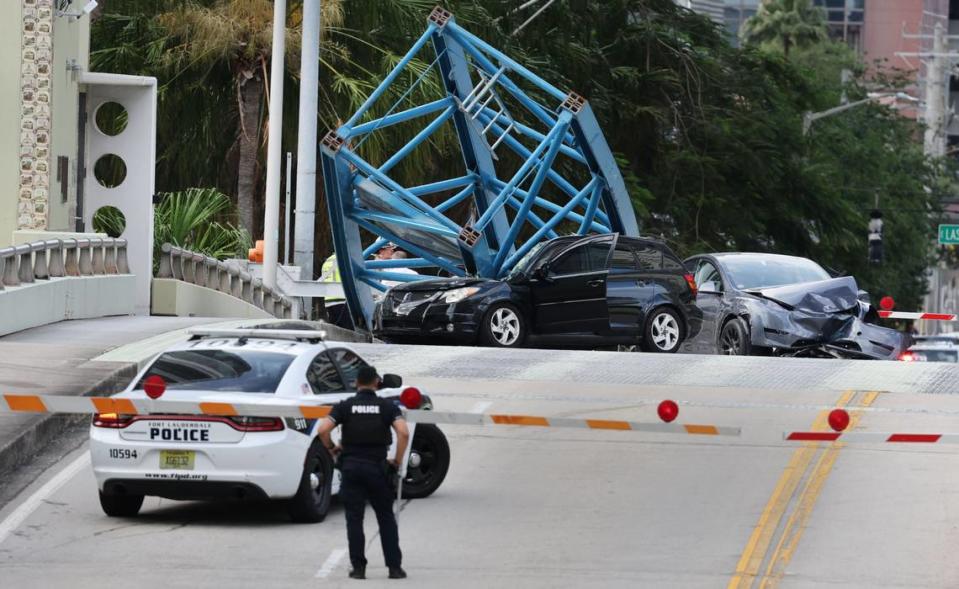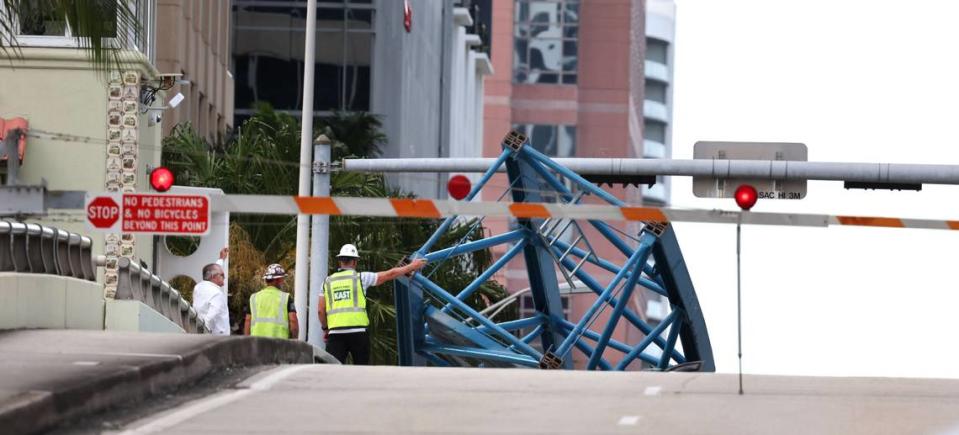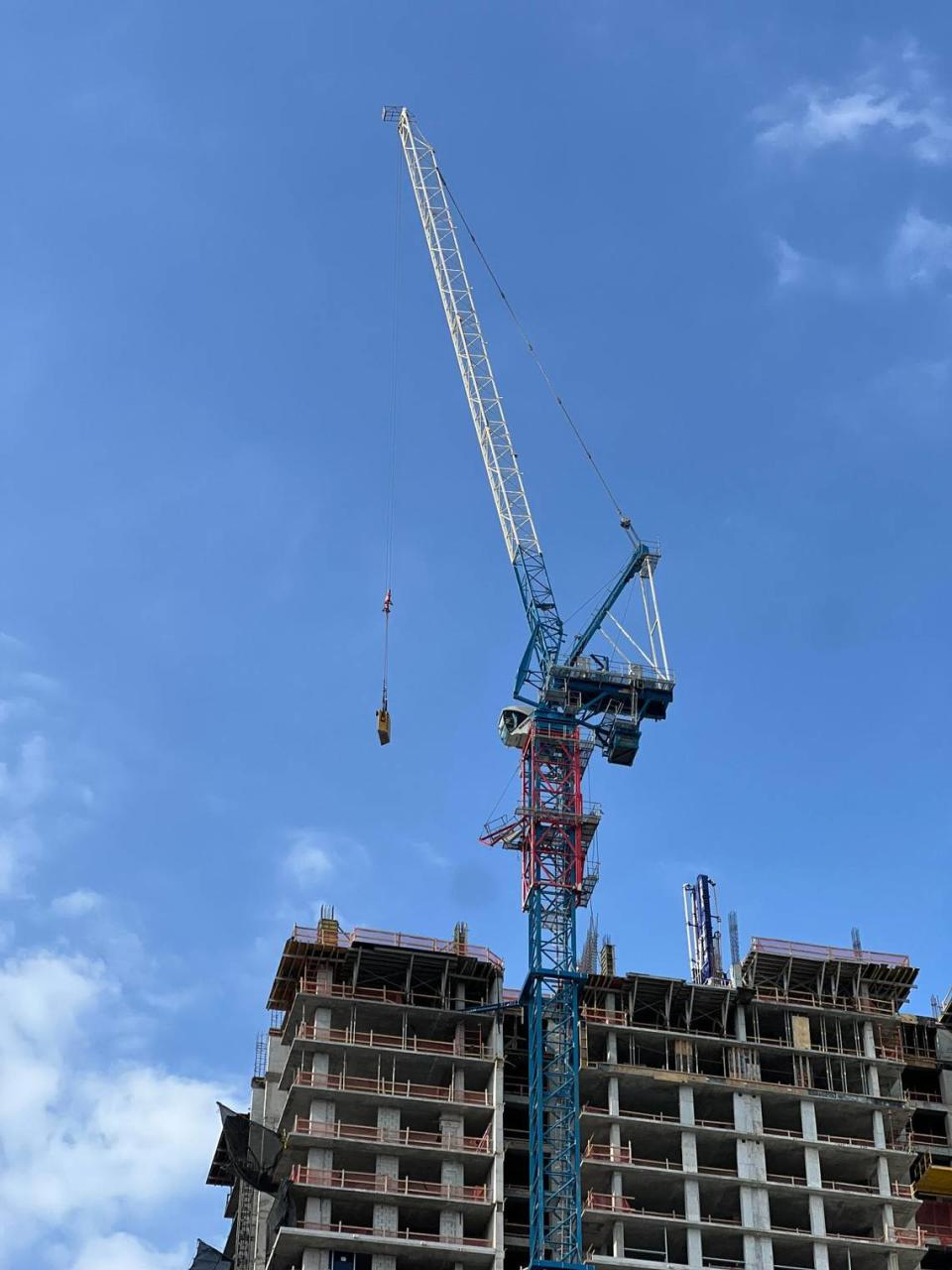What caused a Broward crane to fatally fall during its construction? Experts weigh in
When William Neeley saw the photos and video of a heavy crane plummeting hundreds of feet onto cars below, his gut told him a catastrophic failure occurred, he said to the Miami Herald.
It wasn’t just his 41 years of construction crane operation and training expertise that informed his opinion. He knew that specific crane and the crew that was tasked to help put it together atop a Fort Lauderdale construction site.
While he can’t say definitively, it is highly likely a freak occurrence involving the integrity of the equipment being used was at fault — causing a failure the likes of which he has never seen in his career.
On Thursday, part of a crane’s heavy metal framework plunged onto the Southeast Third Avenue bridge while a construction crew was putting it together. When it landed, the piece sheared off the front ends of two cars, punching a hole in the bridge.
A construction worker, 27-year-old Jorge De La Torre, was killed and three others were injured.
READ MORE: 1 dead as Fort Lauderdale building crane fails, crushes cars on bridge

Experienced crew and a crane in perfect condition
The crane was in the process of being “stepped up” or “jacked up,” meaning sections of it were raised individually to construct it and make it taller, according to Fort Lauderdale Fire Rescue officials and Neeley.
“It happens hundreds of times a day across the U.S.,” said Neeley, referring to the common practice of ”jacking up” a crane.
While the work being conducted was routine, he said in the crane industry it is the most treacherous position a worker can be in.
“That is the most tedious and most dangerous spot that you can ever put yourself in, by far,” he said, adding it takes a lot of time and concentration.
Neeley doesn’t believe the crane operators or the crew tasked with constructing it are to blame for the collapse due to the life-threatening nature of the work.
The Occupational Safety and Health Administration has opened an investigation into the West Palm Beach-based company Kast Construction; Phoenix Rigging & Erecting LLC of Mableton, Georgia; and Maxim Crane Works LP of Wilder, Kentucky.
READ MORE: OSHA investigating construction companies tied to fatal Fort Lauderdale crane incident
It has not been officially stated what role each company played, but KAST holds the permit to the $87.9 million project site in Fort Lauderdale where the crane appeared to be located. In Neeley’s experience, the most likely relationship is Kast contracted Maxim for crane work, and Maxim, in turn, contracted Phoenix Rigging to assemble their crane.
All three companies could not be immediately reached for comment.
Before his time at Crane Tech, where he currently trains crane operators around the country for organizations like NASA and Space X, he worked with Phoenix Rigging’s construction crews. Specifically, he knew De La Torre and the team he was on.
“Bless his heart and his family,” he said. “That’s the tragedy here behind this, the loss of life and the injuries on the ground. It is really hard to hear.”

Neeley said De La Torre’s crew was “very experienced”, spending about the last two decades rigging and constructing cranes. The crew was meticulous with their work and would follow procedures closely, he said.
He believes a platform used for placing crane sections on its way up gave way, causing the fall and fatality. Normally, the platform is supported by two cables, and one was missing, according to pictures and video Neeley analyzed after the incident.
It’s unclear if the cable breakage was the root cause or happened after the piece fell. Regardless, he has never seen a platform fail in such a way.
“It’s odd to me when you look at how [the remaining cable] laterally twisted. It tells me one side of the platform gave way and dumped the [crane section],” said Neeley, pointing out metal fatigue could have been a cause of the cable break as well, along with a number of other factors that OSHA is most likely investigating.
He assumes De La Torre was on the platform assisting with resting the crane piece. As for why he possibly was not wearing a support harness, Neeley said that under OSHA regulation, as long as a railing system is in place, harnesses are not required.

Apart from the crew, he is sure that the crane itself was not at fault either. In years past, he had dealt with the exact crane at the heart of the fatal incident.
He and a past employer bought the crane at an auction but never assembled it because it had “quite a few issues at the time.” Another construction company then purchased the crane and spent a large sum of money to get it in safe and “perfect” working condition, said Neeley, who also witnessed the rebuilding process.
“I don’t think there is any doubt that the crane was functioning properly,” he said. “All I saw was a platform broken off...in such a way it appears suspicious to me.”
Florida laws make regulation, litigation difficult
In Florida, OSHA is the only agency that can regulate hoisting equipment, such as cranes, according to state statutes. Local governments and their building inspectors are barred from implementing their own regulations and ordinances regarding the equipment that populates most of the downtown skylines of Miami-Dade and Broward counties.
The City of Fort Lauderdale’s Building & Construction Office confirmed to the Herald that they have no regulations for cranes.
Attorney Michael Levine, a partner at Stewart Tilghman Fox Bianchi & Cain, P.A., said the lack of regulation and fewer eyes on construction sites can lead to an increase in fatal and harmful incidents.
“We’ve obviously been in this period of rapid overdevelopment throughout South Florida. There’s a ton of cranes that just top the skyline every day,” Levine said. “You’ve got people that want to push projects through, move quickly, and that leads to cutting corners.”
READ MORE: Several South Florida crane-related incidents have injured workers. Here’s what happened
Levine’s office is handling two crane-related accidents, one involving amputation and another where a man was thrown from the sixth floor of a construction site.
Apart from tight oversight, he said the practice of contractors hiring subcontractors who then hire sub-subcontractors leads to loosening safety practices, which may have occurred in Thursday’s fatal crane incident.
“You’ve got a lot of people coming and going from a job site; many times, nobody knows exactly who they’re working for,” he said. “From my experience, it’s apparent that with the shifting of people and contractors and subcontractors, you’re not always getting that uniformity in direction, in implementation of policies and procedures, and in workplace safety training.”
When these safety lapses lead to death or serious injury, Levine said, the aftermath to seek composition or other legal remedies is also a strenuous process.
“Florida law makes it very difficult to pursue a lawsuit against your employer when you’re hurt or killed on the job.” he said.
Due to Florida’s workers’ compensation law being a no-fault system, he said, while employees can get some of their wages replaced or medical bills covered, they exchange that for their employers receiving more immunity from lawsuits.
“The law is stacked against the employee who gets hurt or killed on the job due to the negligence of their employer, and they’re going to have to overcome a lot more obstacles,” he said.

